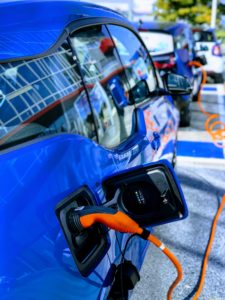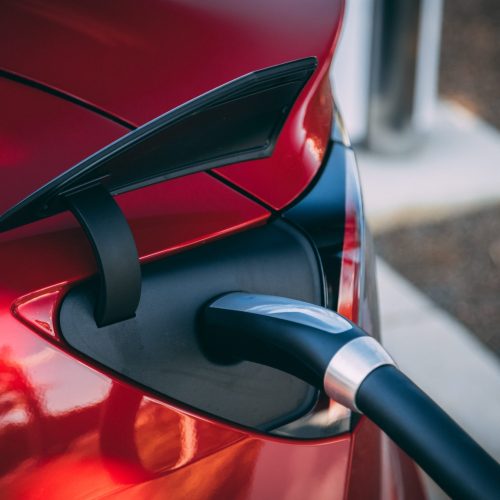Considerations when buying an Electric Vehicle
Thinking of buying an electric vehicle (EV)? There are pros and cons in owning an EV, but knowing more about the process and the differences between daily operations of driving an EV will make you a more informed buyer. No one likes surprises after they make a major purchase like a car! EV’s are good for the environment, but there are environmental concerns to be aware of in the production of electric vehicles and their batteries. In this article, I have tried to outline the positives and negatives of EV production and ownership.
I interviewed an EV owner (thanks Irene!) who has had her 2017 Chevy Bolt for about 3 years. After getting over  the initial “anxiety” over running out of charge, she felt quite confident about how far she could travel. She loves the fact that she has no emissions while driving, experiences quick acceleration, and has a smooth quiet ride. She also likes the fact that there is no periodic maintenance to attend to on the motor itself.
the initial “anxiety” over running out of charge, she felt quite confident about how far she could travel. She loves the fact that she has no emissions while driving, experiences quick acceleration, and has a smooth quiet ride. She also likes the fact that there is no periodic maintenance to attend to on the motor itself.
People are primarily motivated to buy an EV because of the decreased effect on the environment and decreased daily operating costs. The $7500 Federal Tax Credit, with an additional $5000 Colorado State tax credit, can reduce the upfront purchase cost dramatically. Keep in mind that these tax credits are only good for the initial purchase, and are not available to subsequent purchasers of used EV’s. New EV cars can sell for anywhere from $30,000 to up to $80,000 and more, so there is a wide range of prices and options available…and it is a quickly evolving market.
According to Edison Electric Institute, as of March 2019, 1.18 million EV’s have been sold in the US. Tesla Model 3 is leading the pack in the reviews per Digital Trends of available EV’s. It has a range of 310 miles/charge and sells for around $40,000. Next in line is the Chevy Bolt, which is “zippy” and has a range of 259 miles/charge. EV owners comment on how quiet the vehicle is to run and they really enjoy driving their vehicles.
Mileage Range/Charge and Charging Considerations: Total miles available to drive on a full charge are increasing with improved battery technology. In 2019, total miles per charge were approximately 200-300. Keep in mind that any draws on electricity (such heat, A/C, radio, lights) will affect the number of miles you can travel on one charge. Having more people (or any increased weight) in the car will also decrease mileage range. Also, batteries prefer staying at 70 degrees, where they will hold their charge the longest. Therefore, parking in the shade (during the summer) may conserve battery charge. Winter and summer battery charges may vary depending where you live, so ask questions of the dealer in your own vicinity. The EV owner I talked to said she actually had less range in the winter, but she learned how to extend the range by using her seat and steering wheel heater (as opposed to heated air), as those heaters did not draw from the driving battery system. Irene found that how she drove her car affected how far she could travel on a charge. For example, by driving 65 mph (as opposed to 75mph) on the highway, she extended her mileage range significantly. There is also a Regenerative Braking System, which transfers kinetic energy back into the battery upon stopping. If you are considering purchasing an EV, look at how many miles you will generally drive each day to work or school and back. Most people that purchase an EV still own a hybrid or a gas vehicle for longer trips.
Charging at home during the night is the most convenient way to charge your vehicle, because of the number of hours it usually takes to complete a charge. Plugging the vehicle into a standard 120-volt wall socket can take up 8-16 hours or more for a full charge (2miles/Hour according to my Bolt EV owner friend), depending how depleted the battery is when starting the charge. Another option is to have an electrician install a dedicated 220-volt line in your garage, which will charge your vehicle in half the time (about 25 miles per hour of charge). Some models (Leaf) sell a “Quick Charger Port” option for about $700 that also significantly decreases the charging time on your vehicle. Ask about specific options for the make and model you are considering.
More charging stations are available in some cities, some free of charge and some pay-per-charge, but you must plan ahead because they are still few and far between. Running totally out of battery charge will not only strand you on the side of the road, but is ill advised as it will deteriorate the battery and reduce its longevity. Most new EV’s are sold with an 8-year, 100,000-mile warranty on their battery, so the battery may last the life of your owning the vehicle. Replacement batteries have a wide range of costs, a Leaf replacement being ~$5500 and a Bolt over $15,000.
Resale of your vehicle may have its own challenges, especially if you are nearing that point in time and/or miles where the battery will require replacement. The purchaser will not have the same tax credit advantages as the original owner, and the EV technology may have advanced to a point where the vehicle you own is no longer desirable.
There are definite advantages to owning an EV. In particular, daily operating and maintenance costs are significantly less over time. Electricity costs will vary depending upon where you get your electricity and the cost of your home electricity. One EV car owner installed solar energy panels on their home to keep their energy costs down. Of course, the costs of purchasing and installing solar panels (although subsidies are available with solar panels too) can be relatively significant…and you should live in a sunshine state to make them cost effective!
If you do not have solar panels and are paying for electricity (most likely powered by coal or natural gas), here is a comparison between EV and gas vehicle cost, per the Idaho National Laboratory. Older EV’s get 2 miles/kWh (kWh is Kilo Watt Hour) whereas newer EV’s can achieve 6 miles/kWh. If we look at an EV that can travel 3 miles/kWh and the electricity in that region costs 10 cents per kWh, the vehicle will cost 3.3 cents/mile to run. If you take a gas vehicle that can go 22 miles/gallon and gas is selling at $2.50/gallon, it will cost approximately 11 cents/mile.
Maintenance costs on an EV are significantly less than on a gas-powered vehicle, as there are no periodic maintenance schedules (like oil changes) required on the electric motor. However, wear items such as tires, brakes, and suspension parts will require replacement periodically, similar to a standard gas vehicle. EV’s are also more efficient, with the distance travelled per dollar of energy is nearly double in an EV as compared to a gas-powered vehicle (Idaho National Laboratory- Advanced Vehicle Testing).
Although an EV does not produce carbon emissions upon driving, a person should be aware of where the electricity comes from to power the vehicle, which is not necessarily environmentally friendly. In countries like France or Norway, where the electricity is produced primarily from nuclear power or renewable sources, carbon emissions are minimal. However, when EV’s are charged in the US and other countries (Germany, Netherlands, and the UK) that derive their power primarily from coal-burning power plants, there still is a carbon footprint for the operation of these vehicles. (See footnote for El Paso county MVEA details). However, EV’s are still significantly more efficient (60-80% efficient) than gas-powered vehicles (20-60% efficient) in transferring their energy source into actual power. (Engineering.com)
Emissions that stem from the production of lithium batteries used in EV’s are a concern because of the mining methods utilized. Electric vehicles run on lithium ion batteries, similar to the batteries we use in our phones and computers, simply larger. Nothing to date surpasses lithium batteries for length and amount of charge they can supply. As the demand for these batteries has increased, so has awareness regarding the concerns surrounding the mining, manufacturing, and recycling processing of lithium, nickel and cobalt used in EV batteries.
The majority of lithium used in EV batteries comes from the “Lithium Triangle”, a corner of the Andes mountains between Chile, Bolivia, and Argentina. In this region, lithium is taken primarily from salty brine flats. This type of lithium mining requires 500,000 gallons of water to mine a ton of lithium, with evaporation requiring a 12-18 month time period. (There are 907 kg per 1 US ton, each battery uses about 12 Kg, which would produce ~75.5 batteries/ton.) Because this is an arid region (engineering.com) and due to the contamination of the water left over following the lithium extraction process, there are significant environmental concerns surrounding this process. It also limits the water available for agricultural uses. According to Cairn Energy Research Advisors, the “lithium ion industry is expected to grow from 100 gigawatt hours (GWh) of annual production in 2017 to 800 GWH in 2027” due to the increased demand from EV production, as well as other assorted electronic devices.
There are other regions where lithium can be mined, so there does not appear to be a shortage. However, we do need to be aware of the environmental concerns surrounding lithium mining. Recycling of lithium batteries is not widely used, due to the poor quality of lithium that is reclaimed and also due to the expense required to the recycling process.
The mining of nickel also has environmentalists concerned. From The Guardian, problems with nickel mining include air pollution from sulphur dioxide in the air, “cancerous dust” on the mined earth, and polluted water running into the rivers. In 2017, the Philippines closed or suspended 17 mining operations. It has been long recognized that the Norilsk Nickel company in Russia (and elsewhere) has significant air and water pollution, which they are making some strides at controlling https://en.wikipedia.org/wiki/Nornicke.
The concern with cobalt mining stems primarily from the use of child labor in the mining process, although the health effect on the health of the miners is less well understood or studied. Approximately 60% of the world’s cobalt is found in the Congo, where the impoverished people will do whatever work is available to make money. It is estimated that at least 35,000 children are utilized to mine the cobalt there, under dangerous conditions without safety regulations or protective clothing.
Advances are being made in the production of EV’s, to increase driving efficiencies as well as to decrease the impact on the environment. I am confident that progress will be made in years to come in all these areas, and that the number of EV’s on the road will continue to increase. Weighing the positives and negatives surrounding both production and ownership of EV’s will make all of us more informed buyers.
Footnote: According to Mountain View Electric Association (MVEA), 63.6% of electricity comes from fossil fuels (natural gas, coal, and petroleum). Renewable (primarily wind, solar and hydropower) account for 16.9%.



